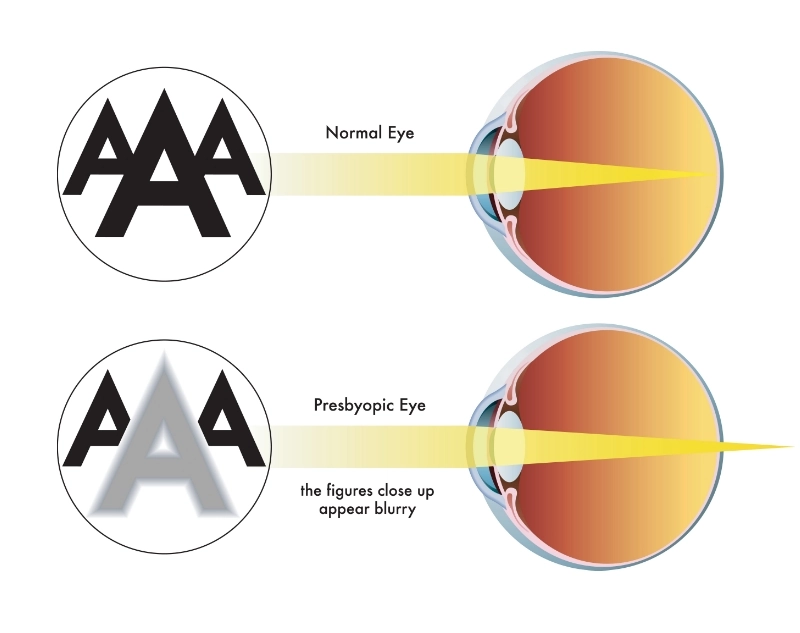Are you beginning to have trouble reading the menu in restaurants with dim lighting? Or holding reading material at arm’s length to be able to see the words clearly? Have you made the move to reading glasses? If so, you’re most likely encountering symptoms of presbyopia, or age-related near vision loss.
At Alliance Vision Institute, we understand that presbyopia can be incredibly frustrating for our patients from the Fort Worth, Dallas, and the DFW areas. While reading glasses may temporarily help, many patients find them to be cumbersome, unattractive, or inconvenient. We offer more permanent solutions for presbyopia that can help you reduce or eliminate dependence on reading glasses.

What is Presbyopia
Presbyopia is a normal part of the eye’s aging process that begins to affect most people in their 40s. With age, the lens of the eye loses elasticity and becomes less able to flex. This causes light to be refracted (bent) behind the retina, which makes it more difficult to focus on objects up close.
Trusted Source
What is Presbyopia?
1 American Academy of Ophthalmology
Go to Source
Presbyopia
is age-related near vision loss that is not related to the shape of the eye like other refractive errors such as nearsightedness (myopia), farsightedness (hyperopia), and astigmatism.
Symptoms of Presbyopia
People begin to see signs of presbyopia in their early 40s.
Trusted Source
Presbyopia
National Eye Institute
Go to Source
Symptoms
of presbyopia can be worse when a person is tired or in low lighting, and typically include:
- Blurred vision when reading at a normal distance
- Needing to hold objects further from the face to read them clearly
- Trouble reading small print
- Headaches
- Eye strain
Who gets Presbyopia?
Presbyopia happens to everyone. However, certain people may be more likely to develop near vision loss at an earlier age.
Trusted Source
Presbyopia
Mayo Clinic
Go to Source
Risk
factors for premature presbyopia include:
- Farsightedness (hyperopia)
- Diabetes
- Multiple sclerosis
- Cardiovascular disease
- Anemia
- Certain medications
- A previous eye injury
Presbyopia Treatment Options
The frustration of near-vision loss caused by presbyopia is common to all of our patients, but we understand that each patient has unique vision needs and lifestyles. To make sure that each of our patients finds the right presbyopia solution for them, we offer a range of treatment options.
Premium IOLs
For patients who would like to permanently improve their near vision, we offer lens replacement using premium intraocular lens implants (IOLs).
Lens replacement happens most frequently during cataract surgery, where the cloudy natural lens of the eye is removed and an IOL is put in its place. By customizing cataract surgery with the patient’s choice of premium IOLs, we can improve their vision at multiple ranges in addition to getting rid of the cataracts forever.
Because not every patient who wants to improve their vision has cataracts, we also offer an identical procedure called refractive lens exchange (RLE). Not only can patients achieve clearer vision at multiple ranges through refractive lens exchange, but by replacing the eye’s lens we can actually eliminate the chance that the patient will encounter cataracts in the future.
Learn More About Refractive Lens Exchange
Our patients are able to choose from a wide selection of premium IOLs, which can improve near vision, intermediate vision, distance vision, or any combination of those visual ranges. We also have a number of options designed specifically for patients with astigmatism.
Learn More About Premium IOLs
Blended Vision/Monovision
Simply put, blended vision or monovision is a technique that corrects one eye for near vision and the other eye for distance vision. The brain learns to combine the images produced by both eyes, helping the patient see more clearly at a wider range. Many of our patients choose to improve their near vision through laser vision correction such as LASIK or PRK with blended vision/monovision.
Frequently Asked Questions About Presbyopia
If you are over the age of 40 and are having more trouble seeing close objects than you used to, you probably have presbyopia. If you suspect that you have presbyopia, come in for an eye exam and a discussion of your treatment options.
Both presbyopia and farsightedness (hyperopia) affect near vision. However, people are born with farsightedness, which is a result of a cornea that is not as curved as it should be or an eye that is shorter than normal. Presbyopia is acquired, which means that it is not present at birth, and is caused by age-related changes to the lens of the eye that make it difficult to view things that are close-up.
Refractive surgical procedures like LASIK and PRK do allow patients to achieve better near vision, but they do not stop the aging process that leads to presbyopia. If you have already undergone vision correction surgery and are now encountering age-related near vision loss, we can help you find a solution.
LASIK can certainly improve near vision, but it can’t stop the lens of your eye from growing increasingly more rigid. Monovision LASIK can help you see more clearly at a wider range, but many of our patients find that the ideal procedure to treat presbyopia is refractive lens exchange.
A new prescription will certainly help you see more clearly if your presbyopia is in its early stages, but you’ll still eventually need to wear bifocals, progressive lenses, or reading glasses. The only way to truly correct presbyopia is to replace the natural lens of the eye with a premium IOL during cataract surgery or refractive lens exchange.

Ready to Learn More?
1American Academy of Ophthalmology. What is Presbyopia? Available: https://www.aao.org/eye-health/diseases/what-is-presbyopia. Accessed January 5, 2023.
2 National Eye Institute. Presbyopia. Available: https://www.nei.nih.gov/learn-about-eye-health/eye-conditions-and-diseases/presbyopia. Accessed January 5, 2023.
3 Mayo Clinic. Presbyopia. Available: https://www.mayoclinic.org/diseases-conditions/presbyopia/symptoms-causes/syc-20363328. Accessed January 5, 2023.
The doctors at Alliance Vision Institute have reviewed and approved this content.
Page Updated:

